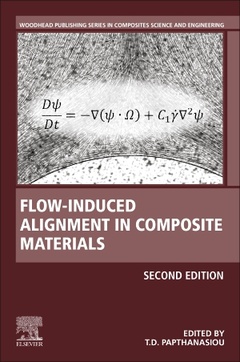Flow-Induced Alignment in Composite Materials (2nd Ed.) Woodhead Publishing Series in Composites Science and Engineering Series
Coordonnateurs : Papathanasiou T.D., Benard Andre

The purpose of aligning short fibers in a fiber-reinforced material is to improve the mechanical properties of the resulting composite. Aligning the fibers, generally in a preferred direction, allows them to contribute as much as possible to reinforcing the material.
The first edition of this book detailed, in a single volume, the science, processing, applications, characterization and properties of composite materials reinforced with short fibers that have been orientated in a preferred direction by flows arising during processing.
The technology of fiber-reinforced composites is continually evolving and this new edition provides timely and much needed information about this important class of engineering materials.
Each of the original chapters have been brought fully up-to-date and new developments such as: the advent of nano-composites and the issues relating to their alignment; the wider use of long-fiber composites and the appearance of models able to capture their orientation during flow; the wider use of flows in micro-channels in the context of composites fabrication; and the increase in computing power, which has made relevant simulations (especially coupling flow kinematics to fiber content and orientation) much easier to perform are all covered in detail.
The book will be an essential up-to-date reference resource for materials scientists, students, and engineers who are working in the relevant areas of particulate composites, short fiber-reinforced composites or nanocomposites.
1 Flow-induced alignment in composite materials: an update on current applications and future prospects Andre Benard and David Guell
2 Fiber
3 Closure models for flow-induced alignment of particles of nearly arbitrary shapes Andre Benard, Liping Jia and Dilip Mandal
4 Macroscopic modeling of the evolution of fiber orientation during flow Julien Fe´rec, Erwan Bertevas, Gilles Ausias and Phan-Thien Nhan
5 Flow-induced alignment in injection molding of fiber-reinforced polymer composites T.D. Papathanasiou, Ines Kuehnert and Nickolas D. Polychronopoulos
6 Control and manipulation of fiber orientation in large-scale processing P.S Allan and M.J Bevis
7 Theory and simulation of flow-induced microstructures in liquid crystalline materials Alejandro D. Rey and Edtson E. Herrera-Valencia
8 Mesostructural characterization of aligned fiber composites A.R. Clarke, N.C. Davidson and G. Archenhold
9 Materials property modeling and design of short fiber composites R. Brooks
Dr. André Bénard is an associate professor in the Department of Mechanical Engineering at Michigan State University. Dr. Bénard’s research interests include sustainable manufacturing and materials processing, multiphase flow and heat transfer (liquid/liquid and solid/liquid mixtures), and the design and modeling of new separation and processing equipment.
- Presents recent progress on flow-induced alignment, modelling and design of fiber and particulate filled polymer composites
- Discusses important advances such as alignment of CNTs in polymer nanocomposites and molecular alignment of polymers induced by the injection molding process in the presence of fillers such as short fibers
- Presents fiber interaction/diffusion modelling and also the fiber flexure/breakage models
Date de parution : 10-2021
Ouvrage de 398 p.
15.2x22.8 cm
Thème de Flow-Induced Alignment in Composite Materials :
Mots-clés :
Characterization parameters; Closure model; Composite materials; Composites; Ellipsoids; Fiber orientation; Fibers; Finite element modelers; Flow-induced orientation; Hele-Shaw flow; Injection molding; Liquid crystal polymers; Liquid crystalline materials; Materials modeling; Measurement problem; Microscopy; Orientation; Reinforcing; Rheology; Short fibers; Skin–core structure; Stiffness; Suspensions; Weldlines



